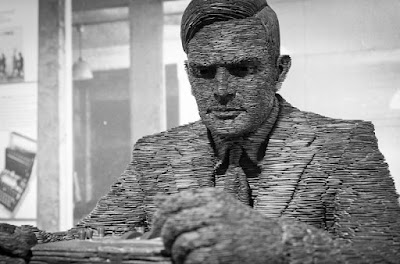 |
| Alan Turing, pictured in a slate sculpture by Stephen Kettle, is known as a computer scientist and code breaker, but also made forays into mathematical biology. Credit: Steve Meddle/REX/Shutterstock |
Topics: Biology, Computer Science, Diversity in Science, Mathematical Models, Nanotechnology
Researchers in China have developed a filter that removes salt from water up to three times as fast as conventional filters. The membrane has a unique nanostructure of tubular strands, inspired by the mathematical-biology work of codebreaker Alan Turing.
The filter is the most finely constructed example of the mathematician’s ‘Turing structures’ yet, and their first practical application, say researchers. “These 3D structures are quite extraordinary,” says Patrick Müller, a systems biologist at the Friedrich Miescher Laboratory in Tübingen, Germany. The filter’s tubular strands, just tens of nanometers in diameter, would be impossible to produce by other methods, such as 3D printing, he says. The work is published on 3 May in Science.
British mathematician Alan Turing is best known for his code-breaking exploits for the UK government during the Second World War, and as the father of computer science and artificial intelligence. But he also produced a seminal work in the then-nascent field of mathematical biology in 1952, just two years before his death.
In it, he proposed a mathematical model for a process by which the cells of an embryo might begin to form structures — limbs, bones and organs. In this process, two substances continuously react with each other but diffuse through their container at very different rates. The quicker-diffusing reactant — called the inhibitor — pushes back against the slower one, called the activator, effectively corralling the resulting product into a pattern of spots or stripes. (The terminology was coined by biologists Hans Meinhardt and Alfred Gierer, who independently formulated an equivalent theory in 1972.)
Water filter inspired by Alan Turing passes first test
Membrane's structure predicted in mathematician's lone biology paper.
Mark Zastrow, Nature
#P4TC: Turing Test...June 10, 2014
IMDB: The Imitation Game
Comments